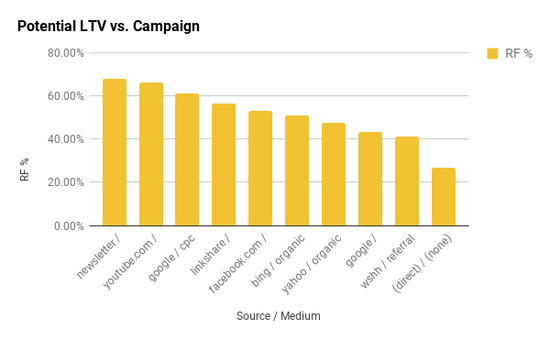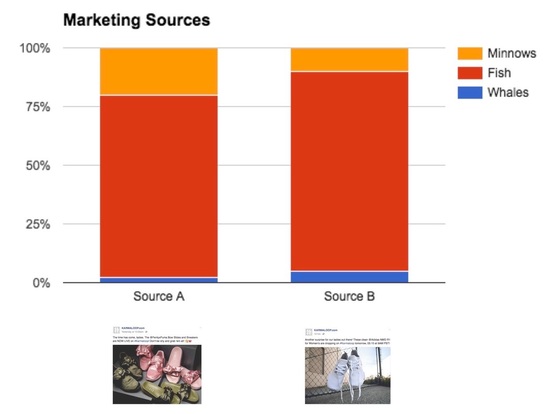Want to find traction, grow profits, and leverage your time? Embrace marketing productivity.
In this post, I review the concept of productive marketing: what it is and why you should embrace it if your goal is to build a highly automated, systematized, cash-flow based lifestyle business. Specifically:
- If you are just starting out, marketing productivity will allow you to start with a small investment and get bigger…without losing money along the way.
- If you are already bigger, then a relentless focus on marketing productivity will allow you to squeeze more profits out of your current operation.
What allows me to travel and work less
So this year my wife and I decided to take a big trip. In April we sublet our NYC apartment, packed up our things, and hit the road with our two kids.
Our travels brought us to the Caribbean, to southern Europe, and now up to Scotland. I’m currently drinking a coffee while writing in Glasgow. (Curious about our travels? Follow my wife’s Instagram—she posts more/better/funnier than I do.)
https://www.instagram.com/p/BXN_FiVl5oT/
The Big Trip has been a great one. I’ve had time to step back, time to think, time to rework my life plan.
One of my top insights: Productivity matters.
“Productivity” is what has allowed me to work a day a week and rest for six. True, I’m not doing nearly as much work as I did in Q1, but the drop-off in income and outcomes that matter have not been that significant.
“Productivity” is what has allowed me to work out one day a week instead of six. We have moved locations every few days. Finding a gym has been hard, so I switched to once-a-week intense workouts instead of a daily session. (Studies support this approach.) I’m not winning any bodybuilding contests, but I’ve maintained my muscle mass.
“Productivity” is what has allowed me to call my mother once a week instead of visiting her daily. Instead of walking two blocks to her apartment and putting in the hours each week hearing about her mahjong class or teaching her for the 50th time how to use Google Photos, now she’s lucky to get a 3 min Facetime with me while I am standing in an airport security line. If there’s free wifi. And the results have been incredible! I can’t stress to you enough the lightness I feel.
As an entrepreneur, you should strive for productivity as much as possible. My definition of entrepreneurship is “accomplishing things with limited resources.” Your most precious resource? Time.
You don’t have enough time to do everything you want with your business. You better damn well focus on the 20% of things that deliver the 80% of your results.
Marketing productivity matters
Nerd Marketing is about marketing productivity.
That’s right—even your marketing should be productive.
Productive marketing is when you can measure the impact on sales of any and all marketing efforts.
In the early days at Design Public, I would buy a keyword in Adwords, and within an hour I’d see how many sales it drove. That’s productive.
Conversely, I signed off on a slew of vanity projects that didn’t directly lead to any measurable sales. I’m thinking of one in particular: inking a deal with Dwell magazine to furnish their concept home in the Bay Area:

Lots of work assembling furniture. Lots of cash tied up in inventory. And no bump in revenue.
(Yeah, that kind of marketing is “invaluable for the brand” but you already know my feelings on that. I can’t feed my kids with my brand.)
When your marketing is productive, it’s accountable to you the entrepreneur. This has two critical implications:
#1 Just starting out? You can start small and scale up
If you are starting out, marketing productivity allows you to start with a small investment and grow your business into something bigger.
In the early days, your primary goal is to see if you even have a viable business, i.e., one that generates cash.
The way to assess this is to toss a bunch of spaghetti up against the wall and see what sticks. Meaning you brainstorm marketing experiments across various channels:
- Facebook ad ideas.
- Content marketing ideas.
- Influencer outreach ideas.
- Heck, even direct mail or an ad in the newspaper.
Doesn’t matter—you just need a lot of potential ideas. (Want a complete list of ideas? Read the book Traction.)
You log each of those ideas and then go to work. You test each one. You measure the results. And you try to find the tests where the following equation holds true:
LTV > CAC
Customer lifetime value (LTV) is greater than the cost it took to acquire that customer (CAC).
For most of you in the early stages, we can even simplify this equation:
Margin on first purchase > CAC
Forget about “customer lifetime.” You simply want to make more money than you spent.
THIS is the essence of product-market fit for a retailer. Until you can make more money than you spend, you haven’t found a market for your product. You don’t have a business.
And your marketing is not productive.
Once you identify a productive marketing test, you focus. You shut down your non-performing tests and see where this one productive test will take you.
Give it some love. Optimize the ad, the landing page, the copy. Layer on cross-sells and post-purchase email campaigns. Increase your spend on it.
With any luck, you can increase your volume while the LTV > CAC equation holds true.
Marketing productivity is what makes it possible. You start with a small investment and keep doubling down on what works. Before you know it you have a big business.
Witness DiscountMugs.com, a leading 9-figure retailer of promotional products. Years ago I worked on a deal to buy this brand. What struck me was that it was built almost entirely on one productive marketing channel: Adwords.
When the founder Amin Ramjee started the company in his garage, he discovered that some of his Adwords campaigns were printing cash. So he kept doubling down on those until, years later, he had bootstrapped a 9-figure revenue business off of a couple hundred bucks in initial spend.

Amin Rahman Ramjee (R) and his warehouse — built entirely off of one marketing channel
One channel is all it took. Marketing productivity.
#2 Bigger business? You can improve your profitability
If you run a more mature business, marketing productivity isn’t about finding product-market fit…
It’s about optimizing your investment portfolio.
You have a marketing budget you can allocate among many different programs. Email marketing, content marketing, affiliate programs—they all represent investments, each with its own return for your time and budget.
Your job is to achieve the best overall return.
As a 9-figure retailer that’s been around since 2003, Karmaloop is obviously a mature business. One of the first things I did as CMO was to run a top-to-bottom audit of my marketing portfolio.
I wanted to find the “dollars out” for my “dollars in” across about 20 different programs.
I call this a Gravy Train Audit—identifying the programs that were printing cash for me…and the dogs that were sucking up my time, effort, and dollars.
More on how to run your own Gravy Train Audit in my next email—but it entails calculating the LTV versus CAC for each marketing program you run.
When ran a Gravy Train Audit for Karmaloop, I first examined marketing channels. I ended up with a chart like this.

Gravy Train Chart comparing aggregate LTV (x-axis) produced by each marketing campaign (y-axis)
As you can see, certain programs on the Y-axis (newsletter, YouTube) were just killing it for us. They were generating $10 in profit for every $1 we spent on them (i.e., they were higher on the X-axis). To extend the investment analogy, these were stocks like Amazon and Netflix, both up over 2000% over the last ten years.
On the other end, I had programs like our affiliate relationship with Worldstar Hip Hop (WSHH). This was my dog, sucking up time and dollars without turning a profit. To extend the stock analogy, this campaign was like a traditional retail stock (JCP or SHLD) down big over the past few years.
I then took the analysis further. I drilled down within each channel.
Different ads, keywords, and offers also have drastically different LTVs and CACs. Part of performing proper marketing diligence at a bigger company is drilling down to the most granular level possible so you can reallocate spend within campaigns too.
This analysis at Karmaloop produced results like the one below. Certain ads were just better at generating higher LTV customers than others:

Example analysis of two ads: Ad B drove more ‘whales’, or high LTV customers than Ad A
With this Gravy Train Audit complete, I was able to reallocate my spend from my dogs to my top stocks. I cut the affiliate program and our WSHH relationship. I took the funds freed up and went all in on email and YouTube.
And within our ad campaigns, we cut all marginal ads and optimized our top performers.
The results were both impressive and immediate. Conversions, transactions, and revenue all increased within months. By the end of one full year, we had gone from losing hundreds of thousands of dollars a month to profitable:

Now, productive marketing campaigns don’t last forever. As with most things, marginal returns diminish as volume increases.
Eventually, as volume increases, all campaigns will become unprofitable.
But your job at as a marketer is to find that break-even point. If you don’t, you are leaving money on the table.
Wrap up
Productivity matters. It’s what will ultimately allow you to lever up your time.
Marketing productivity means you can measure the impact of your spend on revenue.
Facetime your parents from an airport line because then you can seem rushed and claim that the plane is boarding.
If you are starting out, use this “productivity mindset” to run a ton of marketing experiments. Find one that generates cash. Then double down on that campaign and scale your business.
If you are running a bigger business, assess the marketing productivity of every channel, campaign, even ad. More on how to do this next post. Reallocate your time and spend from your dogs to your top performers. Watch your overall business become more profitable.
When your marketing is productive, marketing is an investment, not an expense. Embrace that mentality.
